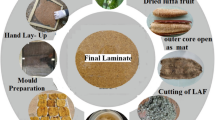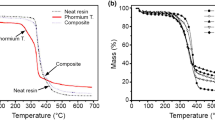Abstract
A study of the durability of fiber reinforced polymer (FRP) materials in seawater and warm environment is presented in this paper. The major objective of the study is to evaluate the effects of seawater and temperature on the structural properties of glass/epoxy and glass/polyurethane composite materials. These effects were studied in terms of seawater absorption, permeation of salt and contaminants, chemical and physical bonds at the interface, degradation in mechanical properties, and failure mechanisms. Test parameters included immersion time, ranging from 3 months to 1 year, and temperature including room temperature and 65°C. Seawater absorption increased with immersion time and with temperature. The matrix in both composites was efficient in protecting the fibers from corrosive elements in seawater; however moisture creates a dual mechanism of stress relaxation—swelling—mechanical adhesion, and breakdown of chemical bonds between fiber and matrix at the interface. It is observed that high temperature accelerates the degradation mechanism in the glass/polyurethane composite. No significant changes were observed in tensile strength of glass/epoxy and in the modulus of both glass/epoxy and glass/polyurethane composites. However, the tensile strength of the glass/polyurethane composite decreased by 19% after 1 year of exposure to seawater at room temperature and by 31% after 1 year of exposure at 65°C. Plasticization due to moisture absorption leads to ductile failure in the matrix, but this can be reversed in glass/polyurethane composites after extended exposure to seawater at high temperature where brittle failure of matrix and fiber were observed.








Similar content being viewed by others
References
Smith, C.S.: Design of Marine Structures in Composite Materials. Elsevier Applied Science, London (1990)
Kootsookos, A., Mouritz, A.P.: Seawater durability of glass-and carbon-polymer composites. Compos. Sci. Technol. 64, 1503–1511 (2004)
Gellert, E.P., Turley, D.M.: Seawater immersion ageing of glass-fibre reinforced polymer laminates for marine applications. Composites 30A, 1259 (1999)
Siriruk, A., Penumadu, D., Weitsman, Y.J.: Effect of sea environment on interfacial delamination behavior of polymeric sandwich structures. In press. Compos. Sci. Technol. (2008)
Bradley, W.L., Grant, T.S.: The effect of moisture absorption on the interfacial strength of polymer matrix composites. J. Mater. Sci. 30, 5537–5542 (1995)
Ellyin, F., Rohrbacher, C.: Effect of aqueous environment and temperature on glass-fibre epoxy resin composites. J. Reinf. Plast. Compos. 19(17), (2000)
Aktas, A., Uzun, I.: Sea water effect in pinned-joint glass fibre composite materials. Compos. Struct. 85, 59–63 (2008)
Wood, C., Bradley, W.L.: Determination of the effect of seawater on the interfacial strength of an interlayer e-glass/graphite/epoxy composite by in situ observation of transverse cracking in an environmental SEM. Compos. Sci. Technol. 57, 1033–1043 (1997)
Ray, B.C.: Temperature effect during humid ageing on interfaces of glass and carbon fibers reinforced epoxy composites. J. Colloid Interface Sci. 298, 111–117 (2006)
Ellyin, F., Maser, R.: Environmental effects on mechanical properties of glass-fiber epoxy composite tubular specimens. Compos. Sci. Technol. 64, 1863–1874 (2004)
Rutowska, M., Krasowska, K., Heimwoska, A., Steinka, E., Janik, H.: Degradation of polyurethanes in sea water. Polym. Degrad. Stab. 76, 233–239 (2002)
Davies, P., Evrard, G.: Accelerated ageing of polyurethanes for marine applications. Polym. Degrad. Stab. 92, 1455–1464 (2007)
Barron, V., Buggy, M., Mas, A., Schue, F.: Durability of APC2/polyurethane adhesive joints for biomedical applications. Int. J. Adhes. Adhes. 20, 361–366 (2000)
ASTM Committee: Standard test method for tensile properties of polymer matrix composite materials. Annu. Book ASTM Stand. 08.01, D 3039-00 (2000)
Abdel-Magid, B., Ziaee, S., Gass, K., Schneider, M.: The combined effects of loads, moisture, and temperature on the properties of E-glass/epoxy composites. Compos. Struct. 71, 320–326 (2005)
Karbhari, V.M. (ed.): Durability of Composites for Civil Structural Applications. CRC, Boston (2007)
Karbhari, V.M., Zhao, L., Murphy, K., Kabalnova, L.: Environmental durability of glass fiber reinforced composites—short term effects. Proceedings of the 1st International Conference on the Durability of Fibre Reinforced Polymer Composites for Construction, 513–524 (1998)
Liao, K., Schultheisz, C.R., Hunston, D.L.: Effects of environmental aging on the properties of pultruded GFRP. Compos. Eng. Part B. 30B(5), 485–493 (1999)
Acknowledgements
This study was supported by the Council of International Exchange of Scholars—Fulbright Scholarship Program, the United Arab Emirates University, and WSU Foundation. The authors thank Dr. Saeed Ziaee for his valuable contribution and appreciate the help of Engr. Abdel-Sattar of the UAEU, and Mr. Jerry Johnson and undergraduate student Nick Neal of Winona State University in material preparation and data analysis.
Author information
Authors and Affiliations
Corresponding author
Rights and permissions
About this article
Cite this article
Mourad, AH.I., Abdel-Magid, B.M., El-Maaddawy, T. et al. Effect of Seawater and Warm Environment on Glass/Epoxy and Glass/Polyurethane Composites. Appl Compos Mater 17, 557–573 (2010). https://doi.org/10.1007/s10443-010-9143-1
Received:
Accepted:
Published:
Issue Date:
DOI: https://doi.org/10.1007/s10443-010-9143-1




